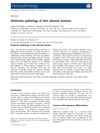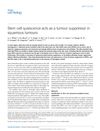TLDR A dog had a rare skin tumor called desmoplastic tricholemmoma.
The document described a rare case of desmoplastic tricholemmoma in a 10-year-old mixed breed dog, characterized by a 0.8 cm facial mass. The tumor, originating from the outer root sheath of hair follicles, was diagnosed through histopathological and immunohistochemical analysis, showing cells arranged in lobules, nests, and cords within a desmoplastic stroma, and positive for cytokeratin 15, cytokeratin 19, and CD34. This case underscored the importance of considering desmoplastic tricholemmoma in the differential diagnosis of canine skin tumors and contributed valuable insights to the limited veterinary literature on this condition.
18 citations
,
January 2013 in “Veterinary Dermatology” K15 is a reliable marker for studying stem cells in dog hair follicle tumors.
37 citations
,
October 2009 in “Veterinary Dermatology” Canine hair follicles contain stem-like cells with high growth potential.
 21 citations
,
July 2006 in “Veterinary dermatology”
21 citations
,
July 2006 in “Veterinary dermatology” CD34 marks potential stem cells in dog hair follicles.
 7 citations
,
March 2017 in “Journal of dermatology”
7 citations
,
March 2017 in “Journal of dermatology” The conclusion is that accurately identifying folliculosebaceous tumors requires understanding their clinical signs and microscopic features.
 16 citations
,
July 2021 in “Histopathology”
16 citations
,
July 2021 in “Histopathology” New markers and pathways have been found in skin tumors, helping better understand and diagnose them.
53 citations
,
January 2013 in “Journal of toxicologic pathology” The project created a standardized system for classifying skin lesions in lab rats and mice.
 66 citations
,
December 2013 in “Nature Cell Biology”
66 citations
,
December 2013 in “Nature Cell Biology” Inactive hair follicle stem cells help prevent skin cancer.

Benign skin tumors need accurate diagnosis to ensure proper treatment.




